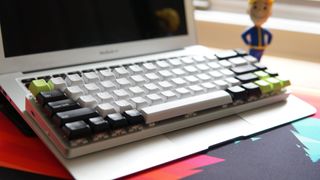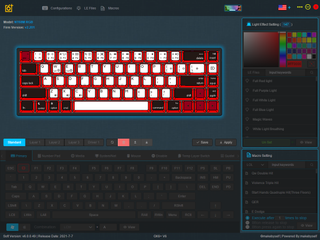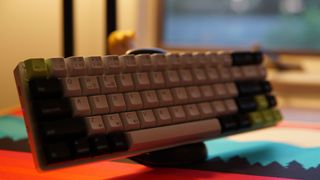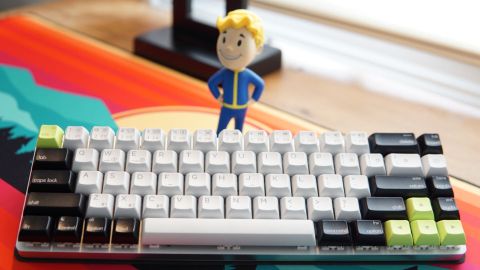Tom's Hardware Verdict
The Epomaker NT68 has some handy features, like Bluetooth connectivity, an impressive battery life and mechanical switches in a compact form factor. It can be used across numerous devices but it needs better keycaps and software.
Pros
- +
Aluminum case
- +
Foldable stand / cover
- +
Long battery life
- +
Hot swappable, including 5-pin switches
- +
Comfy keycap shape
Cons
- -
Poor keycap quality
- -
Short cables
- -
Software profiles only
- -
Software is hard to use
Why you can trust Tom's Hardware
Epomaker has a knack for crowdfunding keyboards with unique design elements and actually bringing them to market. You can find some of its best budget mechanical keyboards all over sites like Amazon, providing some credibility for when it launches a new crowdfunding project.
The Epomaker NT68 Kickstarter launched today with plans to ship in October. It looks to fund a 65% keyboard that’s hot-swappable, so you can easily change your mechanical switches, and connects via Bluetooth. The keyboard mimics Apple’s design language while providing the features expected of a good, enthusiast-level mechanical keyboard. With an origami stand, it’s easy to add mechanical typing to your tablet or phone, and Epomaker even says that the NT68 can sit atop your laptop’s existing keyboard for an instant upgrade -- a particular boon for Mac users.
With an $89 super early bird price and $95 early bird price, however, the flaws that come with this extremely versatile keyboard may be overlooked but not forgotten.
Epomaker NT68 Specs
| Switches | Gateron Black,Blue,Red/Brown or Epomaker Chocolate Blue/Red/Silver/Rose/Brown |
| Lighting | Per-key RGB |
| Onboard Storage | None |
| Media Keys | With FN |
| Connectivity | USB Type-C cable |
| Cable | 8.5 inches (216mm) USB-C to USB-A braided cable; 8.5 inches (216mm) USB-C to USB-C braided cable |
| Additional Ports | 1x USB Type-C |
| Keycaps | PBT plastic |
| Software | Epomaker GK6X |
| Dimensions (LxWxH) | 12 x 4 x 0.5 inches (304.8 x 101.6 x 12.7mm) |
| Weight | 0.8 pounds (363g) without stand; 1.4 pounds (635g) with stand |
| Extra | 1x origami stand/cover, 4x Windows keycaps |
Design of Epomaker NT68

Epomaker seemingly took a page out of Apple’s design book when creating the NT68. This is evident by the aluminum case and the included folding stand/cover people often use with iPads. However, the bulkier, PBT plastic keycaps are where the NT68 starts to stray from that Apple-like approach. That’s a good thing, of course, and a key step in delivering the mechanical experience. I’d rather have legitimate keycaps instead of chiclet or flat ones.
A big selling point of the NT68 is portability, with the brand encouraging you to use it with everything from your laptop to your smartphone. At 1.4 pounds with its stand (0.8 pounds without) and dimensions of 12 x 4 x 0.5 inches, it was easy for me to fold up and take to work.
For comparison, the Cooler Master SK622, a 60% mechanical Bluetooth keyboard, is actually heavier (1 pound, 11.5 x 4.1 x 1.2 inches) and doesn’t come with a carrying case. However, it’s easy to scuff the origami stand/cover included with the NT68. Additionally, the keyboard supports Apple iOS, so I was able to pair it with my smartphone to text friends, but I never felt like my phone sat securely in the NT68’s case. The good news is that I didn’t notice any lag when using the NT68 with an iPhone.
The Epomaker NT68’s keycaps don’t appear to be of very good quality. According to Epomaker, they’re PBT plastic, which is typically considered more premium than ABS. However, they shine like a set of old ABS keycaps. The text on a few of the keys looks very bad too. For example, the right Command key looks very crammed, barely fitting on the keyboard. I can’t ignore how crowded the top row is either.
The NT68 isn’t marketed as a gaming keyboard, but like most of the best gaming keyboards, it comes ready to party with per-key RGB. It’s nice to see but because this is a wireless keyboard, using your RGB's at max brightness will affect battery life (more on that in the dedicated section). It’s bright, and there’s a good number of preset effects available, but RGB doesn’t seem to fit with the keyboard’s overall design, especially with its lean toward Apple fans.
The aluminum chassis on the Epomaker NT68 looks and feels absolutely fantastic. It has that same metallic feeling of a MacBook and just feels so solid. Epomaker’s keyboard also comes with a suede-like case that does double-duty as a stand if you fold it the right way. I want to emphasize “the right way” here because even though I was reading the instruction manual, I could not get the keyboard to sit on the stand properly without the whole thing coming down like Jenga. If folded correctly, you can lay the NT68 on a 6-15.5 degree angle, which will allow for better ergonomics.
One of the things Epomaker emphasizes dearly is the NT68’s ability to sit right on top of your laptop’s keyboard. Because Epomaker includes four Windows keycaps in the box to replace the Apple ones, you can, in theory, sit the NT68 on top of a large number of laptops and instantly add mechanical keys.
However, the keyboard didn’t line up with my late 2013 MacBook Air, causing the keyboard to slide down. Hopefully, Epomaker creates a list of supported MacBooks and Windows laptops because it was disappointing to not be able to use one of its main features with my system. Ultimately, this wasn’t a large issue though because I preferred typing with the keyboard on my desk.
While the height of the GSA keycaps seemed a bit too tall for the design of the NT68, I wanted to try putting a set of Drop MT3 keycaps on, because I was curious to see if the origami case would be able to wrap around the tall keycaps and lock into place and as expected, and it did not. While this isn’t Epomaker’s fault, if you plan on using a tall keycap shape, like MT3, SA or OEM then I would think again if you plan on travelling with this keyboard.
Typing Experience on Epomaker NT68

The NT68 is available with numerous types of mechanical switches from Gateron, as well as Epomaker’s Chocolate brand. My review unit came with linear Gateron Black switches, which feature an operating force of 60g and bottom out at 75g. They have 2mm pre-travel and 4mm total travel.
If you’re looking for a solid, linear switch, you can’t go wrong with Gateron Blacks; however, I recommend that you lube the switches on the mechanical keyboard if you don’t plan on getting aftermarket switches. Hot swappability makes using different switches simple, and the NT68 even accepts 5-pin mechanical switches, like the Kailh x NovelKeys Box Creams, which can provide more stability than their 3-pin counterparts. I also recommend that you lube the stabilizers because I had instances where my backspace key became stuck. It’d be wise to brush the inner housing with Kyrtox 205g0 and dip the ends of the stabilizer wire in dielectric grease.
Like pretty much all of the hot-swappable keyboards on the market right now, Epomaker is using Kailh hot-swap sockets. There’s nothing wrong with hot-swap sockets -- they are extremely convenient -- but I found that the 3-pin switches that were pre-installed offered an immense amount of resistance when I tried to remove them. This can be both a good or a bad thing. Your 3-pin switches are secure, but this could also cause premature socket widening, which is not fun.
On a more positive note, the shape of the keycaps is very nice. They use the GSA profile, which is exclusive for Epomaker. They feel a bit similar to DSA keycaps, which are more spherical and the same height across the keyboard, compared to Cherry-style keycaps, which are cylindrical, vary in height depending on the row the key is in and are much more common, (especially among prebuilt keyboards). But compared to DSA keycaps, the NT68’s GSA keycaps aren’t all the same height.
Keycaps of this profile may take some getting used to, but they’re slightly more concave than Cherry profile, so your fingertips will sit more comfortably without sinking in. I’m really impressed by the keycaps’ overall shape. Although the quality of the plastic is lackluster, the keycaps still felt great to type with because of their shape.
I was concerned about doing heavy typing with the 65% keyboard because it has a small right shift key, but this was actually easy to get comfortable with. I did run into some trouble when using the left Control key; I would hit the larger, left Function key accidentally instead.
I took the NT68 on a few trips through Monkeytype and was able to hit my typical speed and accuracy rate. If you’re used to Cherry MX Red switches though, the most common linear switch, you’ll have to get used to the extra resistance.
Despite the NT68’s metallic chassis and unlubed switches, I didn’t suffer any spring pinging with the NT68. The keyboard doesn’t use any sound dampening material either. There was, on the other hand, an immense amount of stabilizer rattle. But ultimately, with the GSA keycaps, which felt surprisingly great for my first time using them, and reliable Gateron Blacks, this proved to be a reliable, satisfying keyboard for getting work done.
Bluetooth Connectivity of Epomaker NT68
The Epomaker NT68 can store profiles for connecting to three different devices using its Bluetooth 5.1 radio. I put the NT68 through a gauntlet, by having it go from an iPhone to a Windows 10 PC and then to MacBook, and switching back and forth -- by hitting Fn + Z, X or C -- was a quick and flawless process. I did not notice even a hint of lag when typing on any of my devices.
Gaming Experience on Epomaker NT68
The NT68 isn’t marketed as a gaming keyboard, but with its small form factor giving you more room for your mouse and many options for smooth, linear mechanical switches -- or whatever switch type you prefer for gaming -- we wouldn’t blame you if you wanted to pair it with your gaming PC for a gaming session or two.
I used the NT68 to play Cuphead and Hotline Miami, which both depend heavily on your reaction speed. Not only was I able to make it through a few levels of Cuphead, I completed three levels of Hotline Miami perfectly. This is impressive performance, showing the NT68 can handle some gaming as well, as long as you like the switches used, (and if you don’t there’s always the option to hot swap the switches).
However, unlike a keyboard geared specifically toward gaming, there are limited gaming-focused features, like macro keys or onboard profiles.
Battery Life of Epomaker NT68

The Epomaker NT68 boasts RGB lighting, but that comes at a cost, namely battery life. According to Epomaker, with RGB enabled, the NT68 will last for 20-80 hours but will stay on for up to 5 weeks with RGB disabled.
I used the NT68 with RGB on at max brightness, and it was still going after 40 hours. Unfortunately, there is no battery life indicator, so I’m unsure how much longer it would last for.
The NT68 charges with the included USB-C to USB-C braided cable. An indicator light turns green once it’s fully charged. The light also turns blue to inform you that Bluetooth is working and is supposed to flash red when battery life is “low.”
Software for Epomaker NT68

The NT68 supports Epomaker GK6X software, but using it is a dreadful task. It’s overwhelming to start, and sometimes launching it resulted in my Backspace key no longer working. The software is good enough for remapping your keys, but don’t expect to quickly change your per-key lighting, because adjusting RGB here is like pulling teeth.
You’ll also have to have the keyboard plugged in order to use the software, which isn’t uncommon among Bluetooth keyboards but still inconvenient -- especially for a keyboard all about portability.
Further, the 8.5-inch cables included with the NT68 aren’t nearly long enough to easily plug into my desktop’s rear I/O. The cables are long enough to connect to the side of a laptop, which is why I assume they’re so short, but Epomaker should’ve included at least a longer USB-C to USB-A cable, since you need it to use the software.
On top of that, you’ll need GK6X to access any of the NT68’s three customized profiles; there’s no onboard memory here.
Bottom Line

The Epomaker NT68 is different from what we’re used to seeing from Epomaker. It’s almost as if the GK68 grew up, got a job at Apple and had to wear a fancy suit to work every day. The aluminum case and suede stand overall are of fantastic quality, and the shape of the GSA keycaps are an absolute joy for typing.
However, the quality of the keycaps’ plastic is a notable weakness. And despite depending on software to access stored settings, the Bluetooth keyboard needs a cable to use its app, and the included cables are inconveniently tiny. On top of that, the software isn’t fun to use either.
Still, Epomaker has found a way to deliver a durable, versatile keyboard with mechanical switches you can change on a whim without breaking the bank. Its mature look makes it suitable for traveling to the office, while RGB and switch variety make casual gaming an option too.

Myles Goldman is a freelance writer for Tom's Hardware US. He reviews keyboards and cases.

Intel reportedly demands all board partners implement Intel Default (Baseline) Profile by May 31 — company hopes to fix issues with some Core i9 chips

'Digital Twins' research gains $285 million in CHIPS ACT funding — virtual chip tech could revolutionize semiconductor manufacturing

Explosive HBM demand fueling an expected 20% increase in DDR5 memory pricing — demand for AI GPUs drives production cuts for standard PC memory
